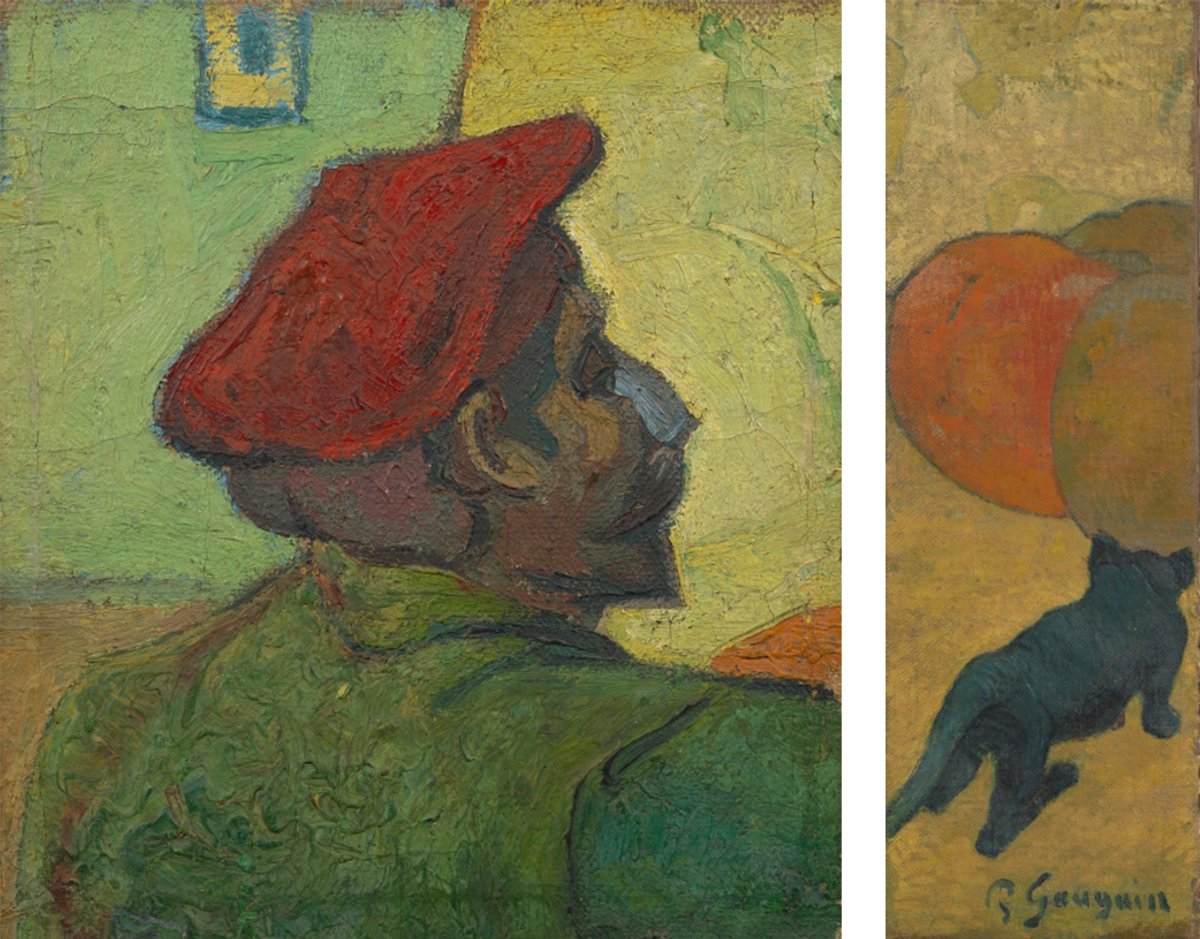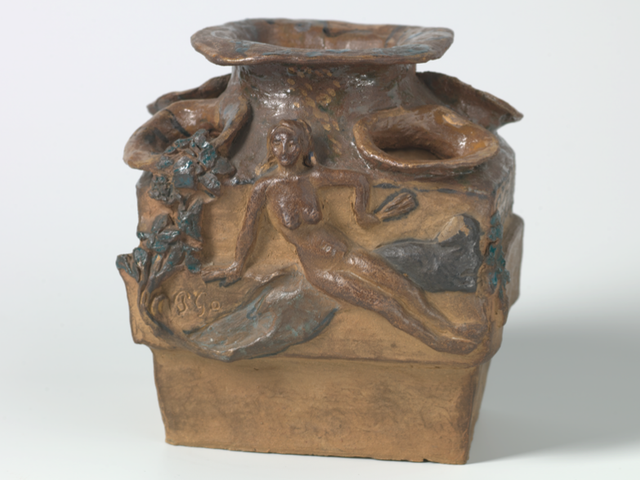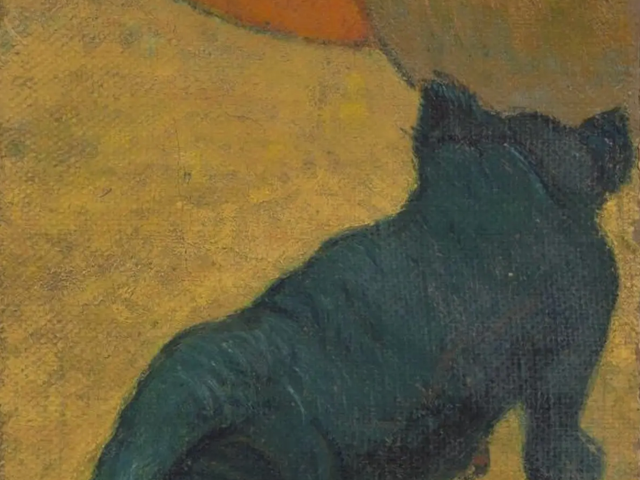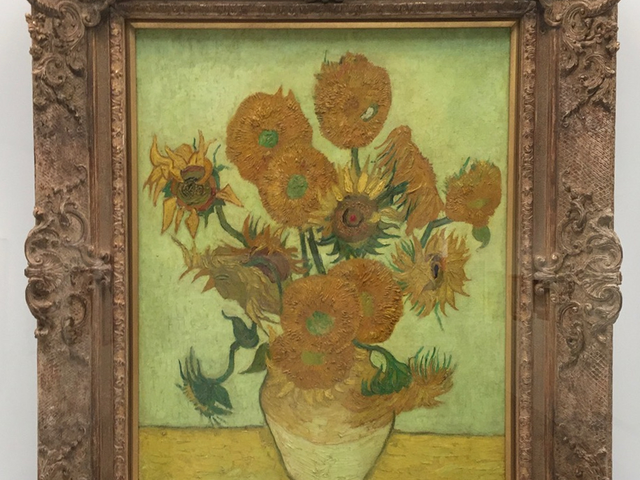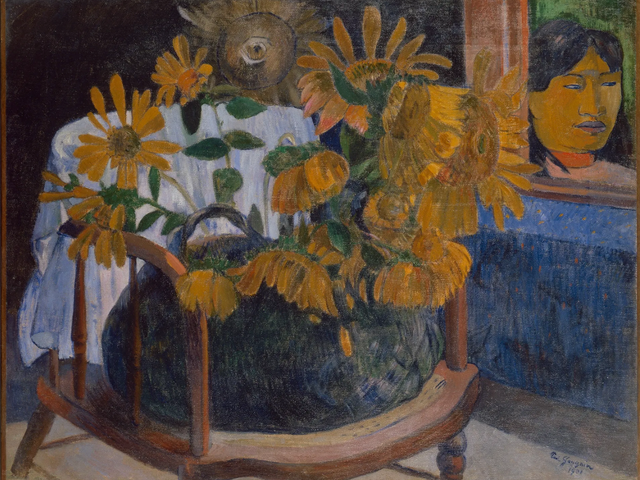Gauguin’s picture The Little Cat (November-December 1888) has just gone on display at Amsterdam’s Van Gogh Museum, after being hidden away in a private collection for well over a century. Conservators have now solved the mystery of its curiously narrow format: it is a fragment which was cut down from a much larger canvas.
There was also a surprise. The remains were found of an unfortunate beetle which had become stuck in the wet paint, in the dark yellow area just below the kitten. This would have happened while Gauguin was staying with Van Gogh in Arles, in the autumn of 1888.
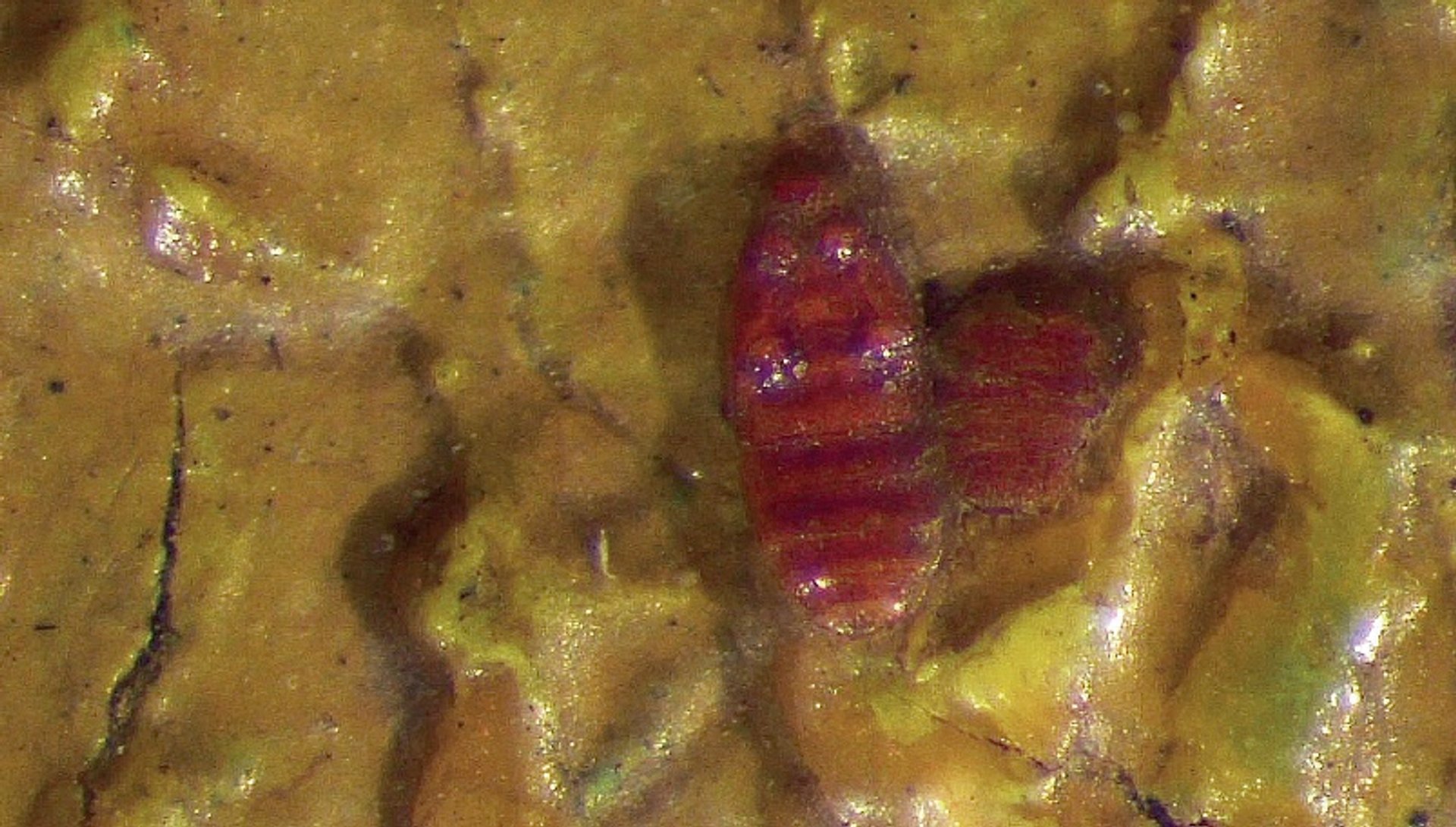
Enlarged image of a beetle embedded in Paul Gauguin’s The Little Cat
Photograph from Van Gogh Museum, Amsterdam
Conservators at the Van Gogh Museum were unable to identify the beetle, since it landed on its back and then lost its head and legs. An entomologist told them that there are around 11,000 different species of beetles in France, very many of which are this small.
Investigations have also shown that both Gauguin’s The Little Cat and Van Gogh’s Portrait of Gauguin (November-December 1888) were painted on coarse jute sacking, from the same 20m length which was bought in Arles at the beginning of November 1888 and used by the two artists during the following weeks.
But most exciting of all, the research confirms a fascinating link between Gauguin’s The Little Cat and Van Gogh’s Portrait of Gauguin. In the portrait by Van Gogh, which has also been cut down and reduced in size, Gauguin is depicted painting a still life (which must have also included the kitten).
Gauguin’s The Little Cat
Gauguin’s The Little Cat is the left-hand fragment of a much larger canvas, most of which was removed and probably destroyed by the artist. Originally the full composition was a still life of a pumpkin and several apples, with the tiny black kitten approaching the giant fruit—a most unusual subject.
Vincent described the picture in a letter to his brother Theo on 21 November 1888. Gauguin was then working on “a big still life of an orange pumpkin and some apples and white linen on a yellow background and foreground”. It may well be significant that Gauguin presented the still life against a yellow background, echoing the colouration of Van Gogh’s greatest Arles painting, his fifteen sunflowers (August 1888, now National Gallery, London).
Specialists at the Van Gogh Museum are now making a fascinating suggestion. If Gauguin was inspired by Van Gogh’s yellow Sunflowers, then this might shed new light on their relationship. Joost van der Hoeven, a museum researcher, says that Gauguin is “often characterised as confident and someone to whom Van Gogh looked up, but maybe the relationship was more one of equals".
For some reason, Gauguin quickly became dissatisfied with his picture. He discarded the main part of the picture (its full size would have probably been around 92cm wide), saving the left-hand quarter (25cm wide) with the little cat. Presumably he kept the image of the kitten to use as a model for a possible future painting.
The hypothesis that the canvas was cut down has now been confirmed by Van Gogh Museum conservator René Boitelle. He found cusping marks (stretched into arched shapes) at the top, bottom and left side, from where the canvas had originally been mounted on a wooden stretcher frame. But there is no cusping on the right side, indicating that it had been cut there. The painted area had also been neatly cut on the right, whereas on the other sides it merges into the unpainted canvas edge.
Van Gogh’s Portrait of Gauguin
Intriguingly, a corner of Gauguin’s lost still life composition—with some of the fruit, but without the kitten—appears in Van Gogh's Portrait of Gauguin. The attribution of this portrait had long been questioned and it was rejected by the Van Gogh Museum in its 1987 catalogue as by an anonymous artist. In 1996 I was the first to argue in print that was genuine—and this was accepted by the museum five years later.
Gauguin, in his red beret, is working on a canvas which is mainly yellow, set at a slight angle on an easel. In front of him is the vague outline of a circular object in orange, presumably the pumpkin.
It is fascinating that conservators have now established that the original composition was cut down by Van Gogh, certainly along both sides and the bottom—and possibly also along the top. Much later, in the 1960s, it was cut down a bit further by conservators, when the canvas fragment was mounted on board.
So why did Van Gogh excise part of his portrait? It may be that he was dissatisfied with the picture, but wanted to save the image of Gauguin, either for possible copying or simply as a memento of their time working together in Arles. But another possibility is that Gauguin disliked his failed still life being depicted and asked Van Gogh to cut it out.
The discovery that Van Gogh’s original composition of the Portrait of Gauguin was larger would help explain the unsatisfactory nature of the remaining fragment—and why it was long dismissed as a fake. The cut-down picture appears clumsy and Gauguin’s facial features appear crude, as if his face was only loosely sketched in.
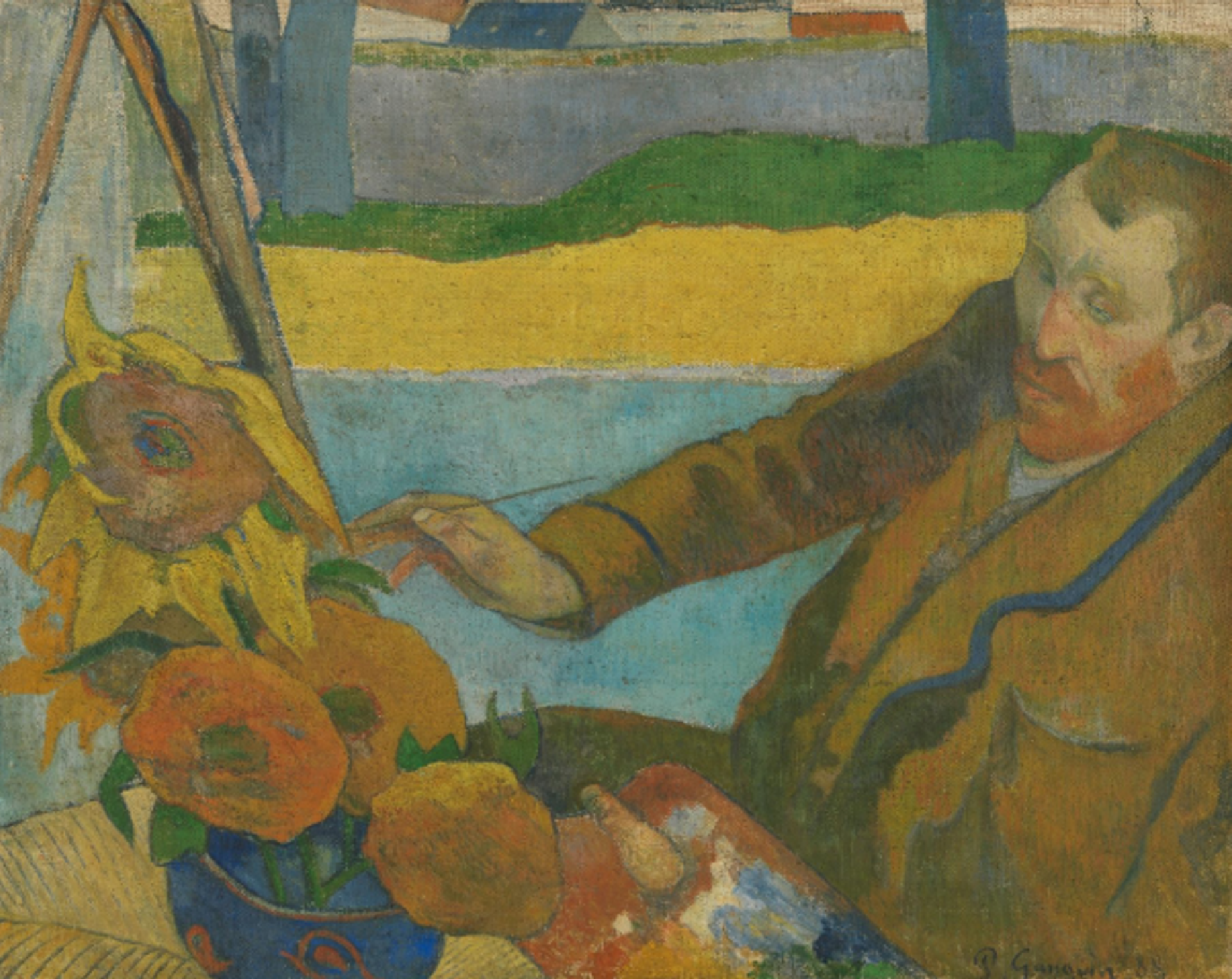
Paul Gauguin’s Vincent van Gogh painting Sunflowers (December 1888)
Van Gogh Museum, Amsterdam (Vincent van Gogh Foundation)
And what would Van Gogh’s original composition have looked like? It might have been somewhat similar to Gauguin’s Vincent van Gogh painting Sunflowers (December 1888), which was done within a few days. If so, presumably more of Gauguin’s still life (including the little cat) would have appeared on the right side and more of Gauguin’s body on the lower side of the composition.
It is quite possible that Van Gogh had been working on a canvas of the same size as Gauguin’s, in which case the surviving fragment with the portrait would have been roughly the upper-left quarter of the original composition. But this remains speculation.
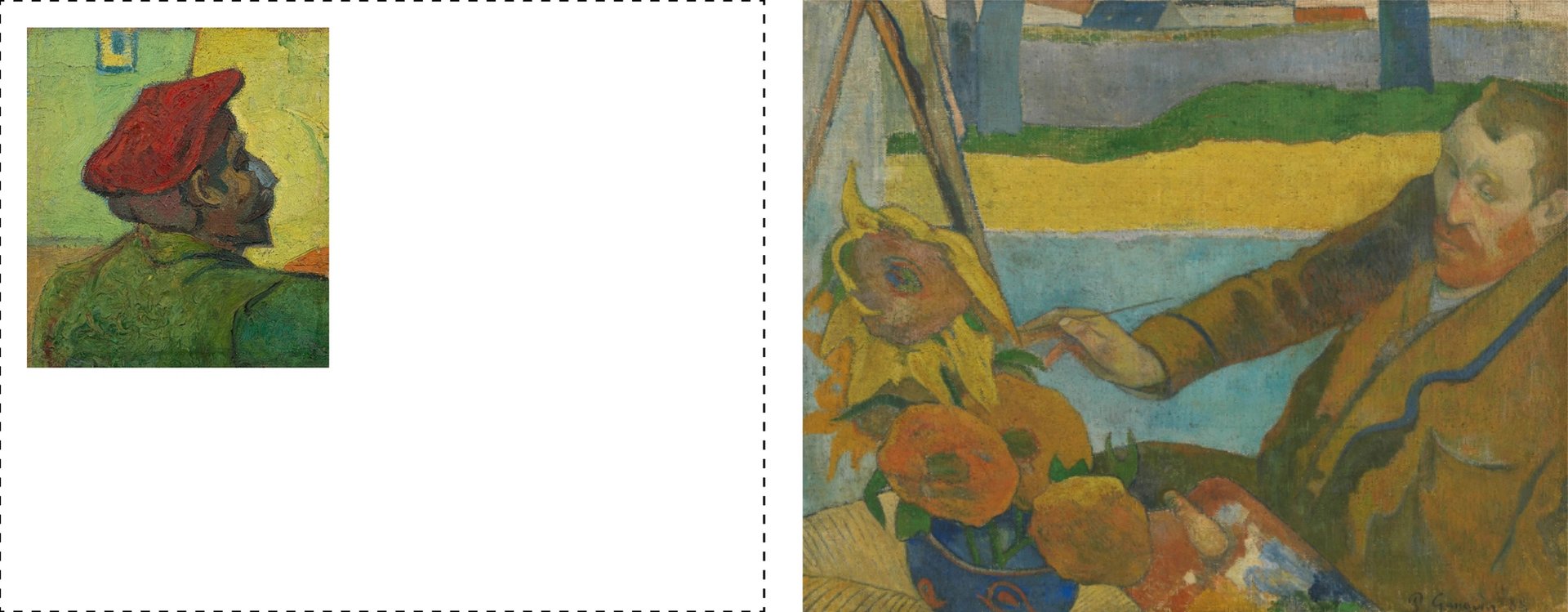
A possible conception of Van Gogh’s Portrait of Gauguin together with Paul Gauguin’s Portrait of Van Gogh
Van Gogh Museum, Amsterdam (Vincent van Gogh Foundation) and private collection, France (photograph from Van Gogh Museum).
The conception is my own
Gauguin’s Vincent van Gogh painting Sunflowers and Van Gogh’s depiction of Gauguin painting his pumpkin and little cat both date from late November or early December 1888. Art historians have always assumed that by this time relations between the two artists were tense, but perhaps this needs to be rethought.
If Van Gogh and Gauguin both painted each other at their easels, it suggests that they then still had a good working relationship. Perhaps it was only later in December, just before Van Gogh mutilated his ear, that their destructive rift occurred.
Meanwhile The Little Cat, on loan from the descendants of the avant-garde French collector Gustave Fayet (1865–1925), will be on display at the Van Gogh Museum until next summer.


